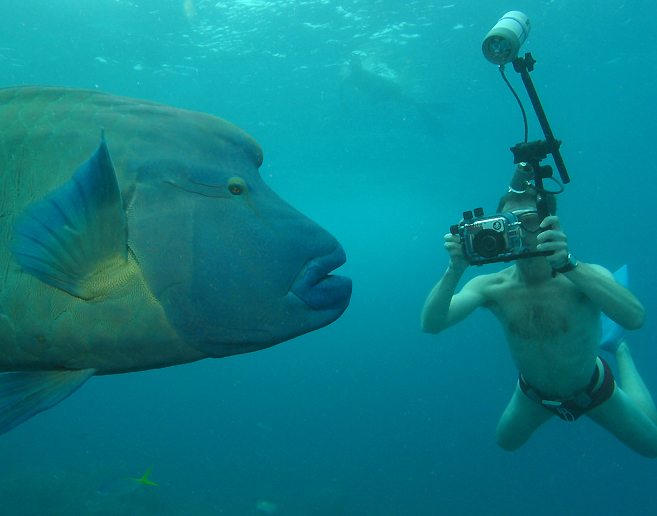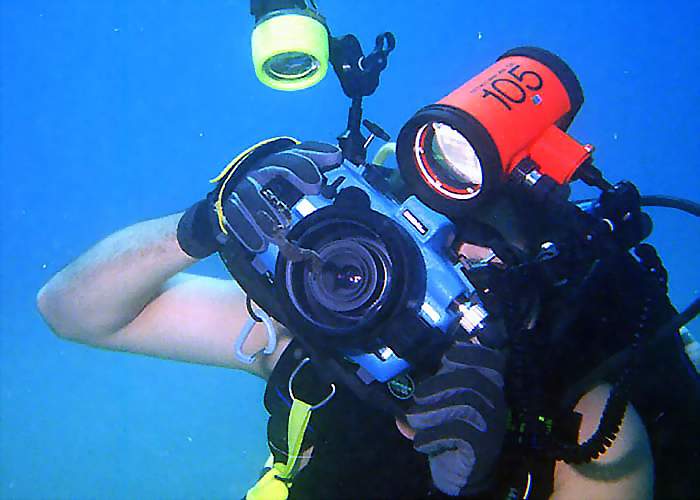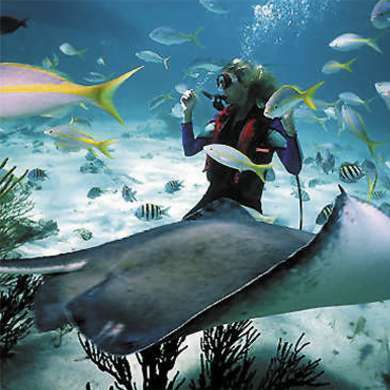When you want to take a photo in the water, not only simple camera which can take a photo but you also need their Equipment as well. Most of Underwater photographers have several basic options for equipment such as A compact digital point and shoot camera, a compact digital camera with full exposure controls, and an SLR.
photo: euphoria-magazine.com
Unlike earlier amphibious or waterproof camera such as the Nikonos, which is designed specifically for use underwater, these cameras now require a housing to keep them water proof. Nikon discontinued the Nikonos series in 2001 and it is a 35mm film system, so it is somewhat obsolete, but some photographers still choose this approach.
Sea and Sea continues to manufacture an amphibious range finder camera that utilizes 35mm film, the Motor Marine III. Housings are specific to the camera and are made of several things from inexpensive plastic to high-priced aluminum cases. Housings allow many options, since the user can choose a housing specific to their everyday "land" camera, as well as utilize any lens in their collection.
In practice, underwater photographers generally use either wide-angle lenses or macro lenses, both of which allow close focus, thereby eliminating the need to have excessive water between the camera and subject. Digital media can hold many more shots than standard photographic film. This is one of the primary advantages of using digital camera underwater, since it is impossible to change photographic film underwater.
Photo: richard-seaman.com
The instant feedback provides faster learning and improved creativity, which is why virtually all underwater photographers now use digital cameras. All underwater housings are outfitted with controls knobs that access the camera inside, giving the photographer use of most of its normal functions. These housings may also have connectors to attach external flash units.
Some basic housings allow the use of the flash on the camera, but the on-board flash may not be sufficiently powerful and are improperly placed for underwater applications. More advanced housings either redirect the on-board strobe to fire a slave strobe via a fiber optic cable, or physically prevent the use of the on-board strobe.
Housings are made waterproof through a system of silicone o-rings at all the crucial joints. There are optical issues with using cameras inside a watertight housing. Because of refraction, the image coming through the glass port will be distorted, in particular when using wide-angle lenses. The solution is to use a dome-shaped or fish-eye port, which corrects this distortion. Most manufacturers make these dome ports for their housings, often designing them to be used with specific lenses to maximize their effectiveness.
The Nikonos series allowed the use of water contact optics: ie, lenses designed to be used whilst submerged, without the ability to focus correctly when used in air. There is also a problem with some digital cameras which do not have sufficiently wide lenses built into the camera. To solve this, there are housings made with supplementary optics in addition to the dome port, making the apparent angle of view wider.
Some housings also allow for the use of wet-coupled lenses, which thread on to the exterior of the lens port and increase the field of view. These wet-coupled lenses may be added or removed underwater, allowing for both macro and wide angle photography on the same dive. With macro lenses, the distortion caused by refraction is not an issue, so normally a simple flat glass port is used. In fact, refraction increases the magnification of a macro lens, so this is considered a benefit to the photographer, who may be trying to capture very small subjects.
Monday, January 26, 2009
Underwater Camera Equipment
Labels: Nikonos, Underwater Camera Equipment
Posted by ThanateTan at 10:27 PM 0 comments
Friday, January 23, 2009
Underwater Photography technique
Underwater photographers combining two techniques for take a shot in the water which dark and dim. The first is to get the camera as close to the photographic subject as possible, minimizing the horizontal loss of color. This is best achieved by using wide-angle lenses, which allow very close focus, or macro lenses, where the subject is often only inches away from the camera. In practical terms, serious underwater photographers consider any more than about 3 ft/1 m of water between camera and subject to be unacceptable. The second technique is the use of flash to restore any color lost vertically through the water column.
Photo: ozancokdeger.com
One other important difficulty in taking photographs underwater is that water is never gin clear, there are always myriads of minute animals and plants and other particles suspended in the water. The lack of clarity limits the distance we can see to about one hundred feet even in the clearest water. Since water is the major obstacle we try to reduce the amount of it between the camera lens and our subject by getting in close, certainly no more than one third of the distance we can see and usually much closer than this.
Since underwater photography is often performed while scuba diving, it is important that the diver-photographer be sufficiently skilled so that it remains a reasonably safe activity. Good scuba technique also has an impact on the quality of images, since marine life is less likely to be scared away by a calm diver, and the environment is less likely to be damaged or disturbed. There is the possibility of encountering poor conditions, such as heavy currents, tidal flow, or poor visibility. Generally, underwater photographers try to avoid these situations whenever possible.
So, to getting close to your subject, an invaluable technique for underwater photography using artificial light is to ensure that as little as possible of the light from the strobe is reflected back into the lens by particles in the water. This can be achieved by holding the strobe higher and to the left of your camera and aiming it at the subject so that only the water nearest the subject, and not the water nearest the lens, is illuminated. Since you need to get close, you should move slowly so as not to disturb your subject. Set up your camera and strobe ready for use before you make the approach, so that if you are using a manual system, you need only to make minor adjustments to the focus and aperture once in the desired position. Try to photograph your subject from an interesting angle, preferably framing it so that the background is not cluttered.
Labels: Underwater photography
Posted by ThanateTan at 6:58 AM 0 comments
Saturday, January 17, 2009
Visit Great Barrier Reef one time make your dream dive
The Great Barrier Reef of the east coast of Australia is one of the wonders of the natural world, it is the world's largest coral reef ecosystem. It was declared a World Heritage area in 1981 and added to the National Heritage List in 2007. It is a site of remarkable variety and beauty on the north-east coast of Australia. It contains the world’s largest collection of coral reefs, with 400 types of coral, 1,500 species of fish and 4,000 types of mollusc.
Photo: thelifeofdavid.com
The Great Barrier Reef can be seen from outer space and is the world's biggest single structure made by living organisms. This reef structure is composed of and built by billions of tiny organisms, known as coral polyps. The Great Barrier Reef supports a wide diversity of life, and was selected as a World Heritage Site in 1981. CNN has labelled it one of the 7 natural wonders of the world. The Queensland National Trust has named it a state icon of Queensland.
The Great Barrier Reef Visitors Bureau also has available a comprehensive selection of support information for the use of the intending traveller.
Photo: duatravel.com
The Great Barrier Reef has long been known to and utilised by the Aboriginal Australian and Torres Strait Islander peoples. Aboriginal Australians have been living in the area from at least 40,000 years ago and Torres Strait Islanders since about 10,000 years ago. For these 70 or so clan groups, the reef is also an important part of their culture and spirituality.
Find Cheap Hotels in Australia.
Labels: The Great Barrier Reef
Posted by ThanateTan at 7:49 AM 0 comments
Tuesday, January 13, 2009
Scuba Driving for Underwater
Scuba diving is swimming underwater, or taking part in another activity, while using a scuba set. By carrying a source of breathing gas, the scuba diver is able to stay underwater longer than with the simple breath-holding techniques used in snorkeling and free-diving, and is not hindered by air lines to a remote air source.
Photo: phuket-trips.com
The scuba diver typically swims underwater by using fins attached to the feet. However, some divers also move around with the assistance of a DPV, commonly called a "scooter", or by using surface-tethered devices called sleds pulled by a boat. Advances in underwater exploration began nearly three centuries ago using diving bells and large cumbersome sealed suits using pumped air from the surface. Only very recently advances in technology and mechanics have allowed people to visit this domain safely for exploration using comfortable, self-contained air delivery systems.
Water normally contains dissolved oxygen from which fish and other aquatic animals extract all their required oxygen as the water flows past their gills. Humans lack gills and do not otherwise have the capacity to breathe underwater unaided by external devices. Early diving experimenters quickly discovered it is not enough simply to supply air in order to breathe comfortably underwater.
Photo: atlastours.net
Today, scuba diving is accessible to almost anyone with only a modest investment in equipment. Anywhere you want to dive you can usually find a dive shop near-at-hand to rent tanks, go on a guided dive with a master diver, take a chartered boat or just strap on the tanks and swim out from the shore.
NAUI, the National Association of Underwater Instructors, was formed in 1960 to regulate and teach safe scuba diving to enthusiasts of this new sport. PADI, the Professional Association of Diving Instructors, was formed in 1967.
Labels: NAUI, PADI, Scuba Driving
Posted by ThanateTan at 9:27 AM 0 comments

